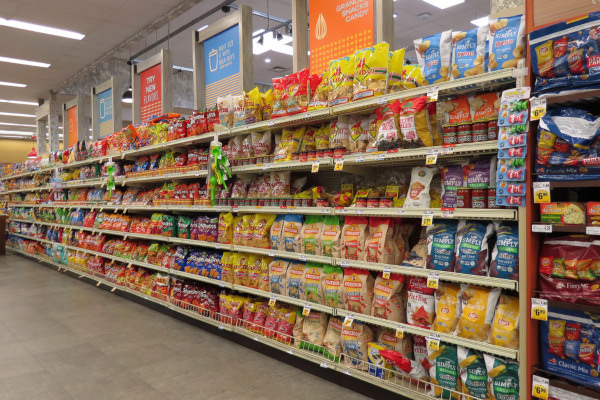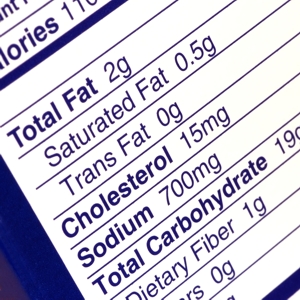Regulators and nutrition advocacy groups across the globe have been trying for years to come up with a simple, easy-to-understand, objective way to gauge the healthfulness of various foods. Nutrition labeling and front-of-package labeling for key ingredients have had some success, but…
 Chips and snacks: an average score of only 16.4/100 on the Food Compass rating scale…
Chips and snacks: an average score of only 16.4/100 on the Food Compass rating scale…
Those in the know say current systems allowing consumers to compare foods based on nutrition colour codes, Nutrition Facts listings (see photo, top of page) and front-of-package labelling for ingredients such as carbs, salt, sugar and calories are doing part but not all of the job. And, critically, the more complex the labelling system, the more confusing it tends to be to the average grocery shopper. And that just discourages the consumer from using the nutrition info aids available to them.
“Once you get beyond ‘eat your veggies, avoid soda,’ the public is pretty confused about how to identify healthier choices in the grocery store, cafeteria, and restaurant,” said the study’s lead and corresponding author, Dariush Mozaffarian, Dean of the Friedman School of Nutrition Science and Policy at Tufts University. “Consumers, policy makers, and even industry are looking for simple tools to guide everyone toward healthier choices.”
Enter, Food Compass
According to a recent article in the journal Nature Food, Food Compass is a quantitative nutrient profiling system, developed over three years at the Friedman School, that incorporates cutting-edge science on how different characteristics of foods positively or negatively impact health.
According to an abstract of the article, “The new Food Compass system was developed and then tested using a detailed national database of 8,032 foods and beverages consumed by Americans. It scores 54 different characteristics across nine domains representing different health-relevant aspects of foods, drinks and mixed meals, providing for one of the most comprehensive nutrient profiling systems in the world.”
“We scored 54 attributes across 9 health-relevant domains: nutrient ratios, vitamins, minerals, food ingredients, additives, processing, specific lipids, fibre and protein, and phytochemicals.” The official article abstract states. “The domain scores were summed into a final Food Compass Score (FCS) ranging from 1 (least healthy) to 100 (most healthy) for all foods and beverages.”
The researchers identified 70 or more as a reasonable score for foods or beverages that should be encouraged. Foods and beverages scoring 31-69 should be consumed in moderation. Anything scoring 30 or lower should be consumed minimally.
Cold, hard numbers
Across major food categories, the average Food Compass score was 43.2. Here’s how the scores for some specific food categories shook out:
- The lowest scoring category was snacks and sweet desserts (average score 16.4).
- The highest scoring categories were vegetables (average score 69.1), fruits (average score 73.9, with nearly all raw fruits receiving a score of 100), and legumes, nuts, and seeds (average score 78.6).
- Among beverages, the average score ranged from 27.6 for sugar-sweetened sodas and energy drinks to 67 for 100 percent fruit or vegetable juices.
- Starchy vegetables scored an average of 43.2.
- The average score for beef was 24.9; for poultry, 42.67; and for seafood, 67.0.
The takeaway
“With its publicly available scoring algorithm, Food Compass can provide a nuanced approach to promoting healthy food choices-helping guide consumer behavior, nutrition policy, scientific research, food industry practices, and socially based investment decisions,” says the article’s last author Renata Micha.
My take
Sounds great! Finally, a simple, objective way to judge the healthfulness of a whole slew of commonly sold and consumed foods! But the development raises some interesting and possibly contentious questions.
First, will the average person use the Food Compass to help make their grocery shopping decisions?
Will packaged and processed food makers, and fast food restaurants voluntarily place the scores on their products’ labels?
Assuming that the scores for Fast Foods and packaged and processed foods will be embarrassingly low, will governments and regulators have to mandate or even legislate the publishing of scores on product labels?
There will undoubtedly be a debate led by food manufacturers claiming that such a mandate would be ‘authoritarian’ and ‘draconian’. They’ve previously agreed to displaying Nutrition Facts, key ingredient amounts and colour codes on labels. My suspicion is that they don’t really believe average shoppers actually rad – much less understand – such existing consumer shopping aids and, therefore, those aids don’t present a real threat to their sales. But will Fast Food, packaged food and processed food giants will see a real threat in clear, objective nutrition labelling, and fight like Hell against having to put it on their products?
How different is mandating the display of Food Compass scores on product labels from the already-required Nutrition Facts and front-of-packaging labels? Is there any reasonable justification for NOT having to post it on product labels?
Muse on that…
~ Maggie J.

